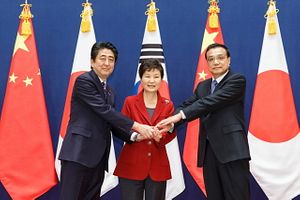After months of anticipation, China, Japan, and South Korea held their first trilateral summit since 2012 this weekend. Chinese Premier Li Keqiang and Japanese Prime Minister Shinzo Abe traveled to Seoul to meet with South Korean President Park Geun-hye on November 1. The three leaders issued a Joint Declaration for Peace and Cooperation in Northeast Asia after their meeting on Sunday (full text available here from Yonhap News Agency).
The declaration took an optimistic view of the thorny relationship between China, Japan, and South Korea. Saying that “steady progress has been made in trilateral cooperation in various areas despite fluid situations in the Northeast Asian region in recent years,” the statement declares that “trilateral cooperation has been completely restored on the occasion of this Summit.” From now on, the trilateral summit “is to be held on a regular basis,” according to the declaration. Such summits were held annually from 2008 to 2012; should a trilateral summit take place again next year, Japan is set to be the host.
Despite the optimism, most of the 2015 declaration sticks to low-hanging fruit such as disaster management, environmental issues, people-to-people exchanges, and deepening economic ties. The declaration included 18 points on “expanding economic and social cooperation for co-prosperity,” 10 on “promoting sustainable development,” and 14 on “enhancing trust and understanding among the peoples.” There were only eight points dealing with security and political issues, and most of those were simply promises of trilateral coordination prior to upcoming multilateral meetings.
Most notably, the three leaders agreed to continue their work toward economic integration by making “further efforts towards the acceleration of the trilateral FTA negotiations.” There are also plans for a wealth of trilateral meetings to advance economic ties and market integration in specific areas, including the Trilateral ICT Ministers’ Meeting, Trilateral Ministerial Conference on Transport and Logistics, Tripartite Customs Heads’ Meeting, and the Trilateral Ministerial Meeting on Science and Technology Cooperation. If the wealth of upcoming meetings is any indication, trilateral cooperation has indeed been “completely restored” — at least on economic and social issues.
On security issues, the North Korea problem topped the agenda. The three leaders “reaffirmed our firm opposition to the development of nuclear weapons on the Korean Peninsula” and emphasized the importance of implementing previous UN Security Council resolutions (which includes resolutions restricting North Korea’s nuclear and ballistic missile programs). The declaration also included a commitment to “to continue our joint efforts to resume meaningful Six Party Talks at an early date.”
Outside of North Korea, no other regional flashpoints – such as the South China Sea issue – made it into the joint declaration. Instead, the leaders kept their discussion broader (for example, agreeing to consultations on counterterrorism and cyber issues). However, South Korea got buy-in from China and Japan on its Northeast Asia Peace and Security Cooperation Initiative, a multilateral platform designed to deal with “low-level” security issues.
The historical issues that helped scuttle the trilateral summit after 2012 were barely mentioned in the declaration. The only reference to history saw all three sides agree to carry out further cooperation “in the spirit of facing history squarely and advancing towards the future,” a common refrain that combines China and South Korea’s insistence that Japan face up to its actions during World War II (and earlier) with Japan’s preference for a future-oriented outlook.
All in all, the trilateral summit was exactly what observers expected – a mostly anodyne dialogue that continued the process of reconciliation between the northeast Asian neighbors without actually attempting to untangle the historical and territorial issues that act as wedges in the various bilateral relationships. Given that this summit hadn’t been held in three years, though, even getting Abe, Li, and Park in the same room together was an accomplishment.

































